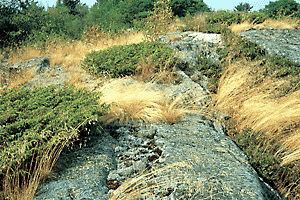Where does the Eastern Massasauga Live?
There are three subspecies under the name of Sistrurus catenatus. There is the eastern massasauga Sistrurus catenatus catenatus, which is the focus of my website, there is the western massasauga, Sistrurus catenatus tergeminus, and the desert massasauga, Sistrurus catenatus edwardsii.
The eastern massasauga rattlesnakes are found from the
upper Midwest to New York here in the United States.
They also live in southern Ontario in Canada.
Eastern massasaugas live in areas of low elevation, ususally near
bodies of water. They like to live in open
areas (like meadows and prairies in which you may find
alfalfa or
cows) around marshes, lakes, and
rivers. They usually are found hiding
underneath bushes and broad-leafed plants.
Midwest to New York here in the United States.
They also live in southern Ontario in Canada.
Eastern massasaugas live in areas of low elevation, ususally near
bodies of water. They like to live in open
areas (like meadows and prairies in which you may find
alfalfa or
cows) around marshes, lakes, and
rivers. They usually are found hiding
underneath bushes and broad-leafed plants.
 Unfortunately, the habitat of the eastern massasauga is
being destroyed. The draining and dredging of
wetlands is the primary cause of the habitat loss.
Along with dredging, the succession of forests into
meadows and prairies has also destroyed the habitat of the
massasauga. The destruction of its habitat
has left the population of the eastern massasauga in a decline,
and it is being considered to be listed as an endangered species
in the US. To the left you can see the range of the
eastern massasauga in Wisconsin.
Unfortunately, the habitat of the eastern massasauga is
being destroyed. The draining and dredging of
wetlands is the primary cause of the habitat loss.
Along with dredging, the succession of forests into
meadows and prairies has also destroyed the habitat of the
massasauga. The destruction of its habitat
has left the population of the eastern massasauga in a decline,
and it is being considered to be listed as an endangered species
in the US. To the left you can see the range of the
eastern massasauga in Wisconsin.
Even when the massasaugas are living in national parks or reserves, they can be killed by humans burning and mowing in their environment. Prescribed burns in parks are to control the level of brush that grows in the area. These burns take place to reduce the risk of a grass fire that could start because of all the dried brush in the area. The problem that massasaugas have with this is that they like to hide in the grass, and they sometimes get caught in the flames and die. Massasaugas are also sometimes killed when brush is mowed down.
 The western massasaugas can be found in Nebraska,
Oklahoma, Texas, Missouri, and Kansas in grassland and in rocky
areas. The desert massasauga lives in Kansas, Texas, New Mexico,
Colorado, Oklahoma, and Mexico in shortgrass prairies.
The habitat of this type of Massasauga is also
disappearing. The loss of its habitat is a
result of construction, farming, overgrazing, and diminishing
water tables.
The western massasaugas can be found in Nebraska,
Oklahoma, Texas, Missouri, and Kansas in grassland and in rocky
areas. The desert massasauga lives in Kansas, Texas, New Mexico,
Colorado, Oklahoma, and Mexico in shortgrass prairies.
The habitat of this type of Massasauga is also
disappearing. The loss of its habitat is a
result of construction, farming, overgrazing, and diminishing
water tables.
 All three of these massasauga types love to find areas in
their habitat to sun themselves. They find a
spot in the open sun and lay coiled to absorb the sun’s rays. The
heat from the sun increases their metabolism and even can help
with the incubation of baby massasaugas inside of the mother.
The area in the image to the left is a very good example of
where a massasauga would sun itself because of the amount of
open space and also the amount of places to hide.
To learn about the different adaptations of the massasauga click
here.
All three of these massasauga types love to find areas in
their habitat to sun themselves. They find a
spot in the open sun and lay coiled to absorb the sun’s rays. The
heat from the sun increases their metabolism and even can help
with the incubation of baby massasaugas inside of the mother.
The area in the image to the left is a very good example of
where a massasauga would sun itself because of the amount of
open space and also the amount of places to hide.
To learn about the different adaptations of the massasauga click
here.